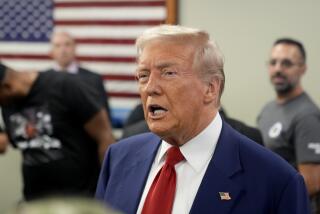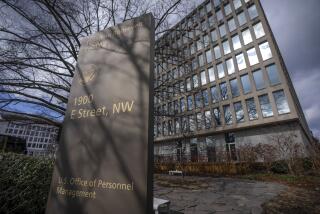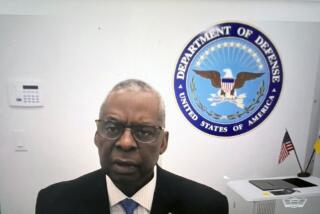White House Hopes Plan of Succession Stays Unused
WASHINGTON — Uncle Sam’s latest doomsday scenario is out. And it’s nothing short of a bureaucratic pecking order that may be unlike any in the history of the republic.
To ensure the continuity of government in the post-Sept. 11 era, the White House detailed the line of succession Thursday for numerous federal departments and agencies, reaching down in the ranks well below top management.
For the record:
12:00 a.m. May 11, 2002 FOR THE RECORD
Los Angeles Times Saturday May 11, 2002 Home Edition Main News Part A Page 2 A2 Desk 3 inches; 73 words Type of Material: Correction
Federal succession-A story in the A section Friday on the expanded succession plans at federal agencies misstated that process. A full tier of senior managers in each agency must be exhausted before the newly added officials would take over. At the Treasury Department, for instance, the secretary and deputy secretary would be succeeded by three deputy undersecretaries (in the order of their swearing-in), the general counsel and the 10 assistant secretaries. The newly added successors would follow this group.
For example, if all the senior executives at the National Archives and Records Administration were to suddenly die or become incapacitated--including the five assistant archivists and the heads of the Federal Register and the National Personnel Records Center--the director of the Jimmy Carter Library in Atlanta would take over as the agency’s head.
The lists were required by the 1998 Federal Vacancies Reform Act. But the task took on new urgency after the terrorist attacks on the World Trade Center and the Pentagon.
The Bush White House disseminated succession lists late last year for a handful of federal agencies and departments.
But in releasing new or updated lists for a dozen government bureaucracies on Thursday, it called fresh attention to the contingency plans to keep the government running--presumably after some catastrophic attack on Washington.
“This is an ongoing effort,” said White House spokeswoman Claire Buchan. “There will probably be more to come.”
To a degree, the heads of each department or agency have some discretion in determining the precise line of succession, Buchan said.
Their decisions no doubt will provide much fodder for discussion and speculation within their agencies.
For instance, at the Treasury Department, if Secretary Paul H. O’Neill and his deputy “died, resigned or otherwise become unable to perform,” the next in line are the fiscal assistant secretary, the chief of staff, the commissioner of the Internal Revenue Service and the commissioner of the Customs Service.
At Justice, those in line to succeed Atty. Gen. John Ashcroft, Deputy Atty. Gen. Larry Thompson and Associate Atty. Gen. Jay B. Stephens are the U.S. attorneys for the southern district of New York, the eastern district of Virginia, Utah, and the western district of Texas.
No explanations accompanied the listing.
There is no uncertainty or discretion, of course, when it comes to presidential succession, which is spelled out in the Constitution.
After the vice president comes the speaker of the House and the president pro tem of the Senate, which is a largely ceremonial office held by the oldest senator in the party that controls the Senate.
The House speaker is Republican J. Dennis Hastert of Illinois; the Senate’s president pro tem is Democrat Robert C. Byrd of West Virginia.
Since Sept. 11, President Bush has taken a number of precautions to ensure government continuity--including occasionally dispatching Vice President Dick Cheney to undisclosed locations to minimize the time that both men are at the White House at the same time.
Without fanfare, Bush also has created what amounts to a “shadow” government, staffed by a rotating group of officials representing key departments and agencies who work at an undisclosed location away from Washington.
A similar precaution, which pre-dates Sept. 11, is taken during a president’s State of the Union address to a joint session of Congress.
Traditionally, virtually every top federal government official, including members of the Supreme Court, attends the speech.
But one member of the president’s Cabinet is kept away from the Capitol.
More to Read
Sign up for Essential California
The most important California stories and recommendations in your inbox every morning.
You may occasionally receive promotional content from the Los Angeles Times.










